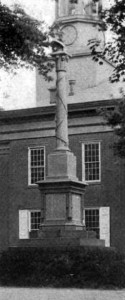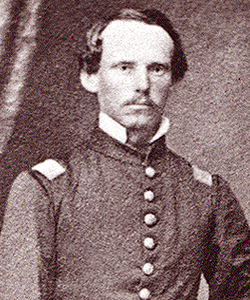 The Soldiers Monument in Carlisle, Pennsylvania was created in a post war effort to honor the Cumberland County soldiers who died as a result of the Civil War. The efforts to build the monument were initiated by the Soldiers Monument Association in early January 1867, which included General Lemuel Todd as Chair, General Robert Miller Henderson as President, and Colonel Erkuries Beatty as Corresponding Secretary. The minutes of the Soldiers Monument Association are available for reference at the Cumberland County Historical Society in Carlisle, Pennsylvania. Fundraising continued into early 1871 until the Monument Association obtained the five thousand dollars needed to erect the monument. The extra money financed the dedication ceremonies as well as the fence that enclosed the monument. A Carlisle mechanic, Richard Owens, was responsible for contracting and designing the monument, which contained a “Roll of Honor” that provided the names of the three hundred and forty-four Cumberland County officers and soldiers that died in combat or during their term of service in the army during the Civil War. The official unveiling of the thirty foot tall Soldiers Monument took place on the Public Square near the Carlisle Courthouse on August 19, 1871 with Lemuel Todd as Chief Marshall of the ceremonies and Major General Heintzelman as the presenter of the unveiled monument. Available on Google Books, Carlisle, Old and New gives a brief description of the monument as well as some of the other historical features in Carlisle.
The Soldiers Monument in Carlisle, Pennsylvania was created in a post war effort to honor the Cumberland County soldiers who died as a result of the Civil War. The efforts to build the monument were initiated by the Soldiers Monument Association in early January 1867, which included General Lemuel Todd as Chair, General Robert Miller Henderson as President, and Colonel Erkuries Beatty as Corresponding Secretary. The minutes of the Soldiers Monument Association are available for reference at the Cumberland County Historical Society in Carlisle, Pennsylvania. Fundraising continued into early 1871 until the Monument Association obtained the five thousand dollars needed to erect the monument. The extra money financed the dedication ceremonies as well as the fence that enclosed the monument. A Carlisle mechanic, Richard Owens, was responsible for contracting and designing the monument, which contained a “Roll of Honor” that provided the names of the three hundred and forty-four Cumberland County officers and soldiers that died in combat or during their term of service in the army during the Civil War. The official unveiling of the thirty foot tall Soldiers Monument took place on the Public Square near the Carlisle Courthouse on August 19, 1871 with Lemuel Todd as Chief Marshall of the ceremonies and Major General Heintzelman as the presenter of the unveiled monument. Available on Google Books, Carlisle, Old and New gives a brief description of the monument as well as some of the other historical features in Carlisle.
Author: mckelveb
 After the outbreak of the Civil War, four volunteer companies originally consisting of fifty to one hundred men were recruited in Carlisle, Pennsylvania on April 19, 1861. On April 21, the officers were chosen with Captain Robert M. Henderson, in charge of Company A of the 36th Regiment, 7th Pennsylvania Reserve Corps. Henderson was assisted in command by First Lieutenant James S. Colwell, Second Lieutenant Erkuries Beatty, and First Sergeant John D. Adair. These men received the nickname “Carlisle Fencibles” in part because most of its members belonged to a gymnastic club and because a “fencible” is a defender of a country. The company spent a two month period of relative inactivity marching and drilling until the soldiers left for Camp Wayne in West Chester, Pennsylvania on June 6. Before the men departed they received a satin flag from Mrs. Samuel Alexander, a granddaughter of Ephraim Blaine, that, according to David G. Colwell, had the inscription “May God defend the right!” The 7th Pennsylvania Reserves went on to fight in the Battles of Gaines’ Mill, Bull Run, and Antietam while suffering great losses. A more thorough description of the experiences of the company is available on Google Books in Samuel B. Bates’ History of Pennsylvania Volunteers, 1861-65 . The wartime experience of one member of the Carlisle Fencibles, John Taylor Cuddy, is chronicled through letters he sent home to his family in Carlisle. His correspondence is available as a part of Dickinson College’s “Their Own Words” digital archive which provides a picture of the experience of a young Carlisle Fencible during the Civil War.
After the outbreak of the Civil War, four volunteer companies originally consisting of fifty to one hundred men were recruited in Carlisle, Pennsylvania on April 19, 1861. On April 21, the officers were chosen with Captain Robert M. Henderson, in charge of Company A of the 36th Regiment, 7th Pennsylvania Reserve Corps. Henderson was assisted in command by First Lieutenant James S. Colwell, Second Lieutenant Erkuries Beatty, and First Sergeant John D. Adair. These men received the nickname “Carlisle Fencibles” in part because most of its members belonged to a gymnastic club and because a “fencible” is a defender of a country. The company spent a two month period of relative inactivity marching and drilling until the soldiers left for Camp Wayne in West Chester, Pennsylvania on June 6. Before the men departed they received a satin flag from Mrs. Samuel Alexander, a granddaughter of Ephraim Blaine, that, according to David G. Colwell, had the inscription “May God defend the right!” The 7th Pennsylvania Reserves went on to fight in the Battles of Gaines’ Mill, Bull Run, and Antietam while suffering great losses. A more thorough description of the experiences of the company is available on Google Books in Samuel B. Bates’ History of Pennsylvania Volunteers, 1861-65 . The wartime experience of one member of the Carlisle Fencibles, John Taylor Cuddy, is chronicled through letters he sent home to his family in Carlisle. His correspondence is available as a part of Dickinson College’s “Their Own Words” digital archive which provides a picture of the experience of a young Carlisle Fencible during the Civil War.
